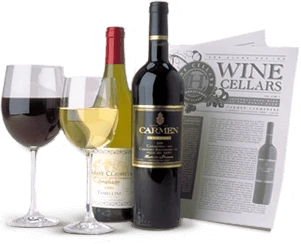The 2004 Monsanto Chianti Classico Riserva is just one more reason why some of Tuscany's most affordable treasures are now also some of Italy's most enjoyable wines. It appears that Chianti Classico has come upon yet another renaissance, thanks in part to Fabrizio Bianchi and his pioneering work at Monsanto. A blend of 90% Sangiovese, 5% Canaiolo, and 5% Colorino, the medium to full-bodied 2004 Monsanto Chianti Classico Riserva captures all the charm, elegance, and structure that one can expect from the finest Chianti Classico. Breed, grace, and plenty of dry, deep down flavor all shine from this offering. A warm scent of cherries, violets, tobacco, and spice tantalize the nose and set the stage for this sophisticated wine's ripe, rich flavors and firm, balanced structure. And already, this 2004 Riserva exhibits a generous, round mouth feel and plenty of ripe tannin, which will undoubtedly carry it for another decade or more. More succinctly, this Monsanto Chianti Classico Riserva reminds us of the Tuscan landscape: elegant, fecund, positively captivating, timeless, and always in good taste. When one looks across the Arno River from Florence and up into the hills surrounding the city or one gazes over the ramparts of rival Siena, a sophisticated, timeless landscape strikes the eye. Happily, Fabrizio Bianchi has captured every bit of that alluring countryside in his 2004 Monsanto Chianti Classico Riserva. Anticipated maturity: 2008- 2018. Saluté!
A superbly crafted Chianti Classico the likes of the 2004 Monsanto Chianti Classico is one of the finest wines to bring to table. So, whether it is homemade focaccia dipped in freshly pressed Extra Virgin Tuscan Olive Oil, herbs, and Pecorino cheese; or Porterhouse Steak grilled to perfection with a brush of olive oil, garlic, mint, and rosemary, this stunning Riserva will surely add elegance and panache to any dinner party. Pheasant stuffed with braised vegetables, porcini mushrooms and a hint of truffle offers another outstanding choice with this wine. Lamb provides a perennial counterpart to great Chianti Classico, too, so why not pair the 2004 Monsanto Chianti Classico Riserva with Lamb Osso Bucco, roast leg of lamb, or herb encrusted lamb chops? However, one should never underestimate the Tuscan love for beans and lentils or the affinity these legumes have for Chianti Classico. In order to highlight the majesty of this exemplary Riserva one could start the evening with a simple Tuscan Ribollita, a traditional Tuscan soup based upon bread, beans, and assorted local fare, or a simple trio of starters that consist of white bean paste, red pepper hummus, and black olive and sun dried tomato tapenade, all served with freshly baked brick oven bread or focaccia. Buon Appetito!
Fabrizio Bianchi is one of Chianti Classico's greatest innovators and artists. A successful textile manufacturer from Milan, Bianchi purchased Monsanto in 1961 and ever since has been a pioneer in Chianti. He acquired Monsanto with "a consciousness that he was walking on a treasure, not of gold, but mere land." What Fabrizio has done with that land is turn it into liquid gold in the form of the finest Chianti Classico and simultaneously transform one of the oldest and most respected wine regions on earth through a series of bold innovations.
Monsanto is a large estate by Tuscan standards (206 hectares or a little more than 453 acres), but only a fraction of the total (72 hectares) is actually under vine. Fabrizio and his family have opted to preserve the natural forests of oak, myrtle, and wild berries that surround the estate, thereby protecting the natural pollinators and indigenous yeasts that abound at Monsanto. And from the very beginning, Fabrizio set out upon refurbishing the estate's vineyards and protecting the special terroir that exists at Monsanto. Consequently, all of the Monsanto's grapes are hand harvested and only the property's natural yeast is employed in fermentation.
With the help of an old cellar foreman, Fabrizio Bianchi fashioned the first Chianti Classico cru in 1962. In 1968, Bianchi took an even bolder step. He eliminated the white grapes from the Chianti Classico cepage or blend in favor of the exclusive use of Chianti's traditional red varieties: Sangiovese, Canaiolo, and Colorino. He also lobbied for permission to use temperature-controlled stainless steel for fermentation, another innovation that is now commonplace in Tuscany but was unheard of three decades ago. The move to temperature-controlled fermentation led Fabrizio Bianchi to take one more pioneering step: the elimination of the governo alla Toscana, an ancient practice whereby whole dried grapes are added to the already fermented Chianti. The result has been cleaner, richer, longer lasting wines that gain both grace and complexity with age. Nearly all Chianti producers have followed Bianchi's lead.
In addition to changing the face of contemporary Chianti Classico, Monsanto has been at the vanguard of Tuscany's renewed interest in traditional French varietals such as Chardonnay and Cabernet Sauvignon, which the Bianchis also fashion into award-winning wines. Furthermore, Monsanto produces a small quantity of a single cru 100% Sangiovese that is labeled Sangioveto Grosso from their Scanni vineyard and a bit of Vin Santo from Malvasia and Trebbiano.
However, what may be the most important part of the landscape at Monsanto is what lies under the ground. The estate's soil is a mixture of the two most important soil types in Chianti: petrified clay stratified in layers and known in Tuscany as Galestri and sedimentary strata of marine sands called tufi. From the layers of rock that undergird the winery, the Bianchis have hewn an 820-foot tunnel to augment the estate's original 18th century cellar. The tunnel took six years to build and was constructed of all natural stones (layers of Galestri) using all medieval techniques and a traditional Etruscan arch. This formidable space houses 1,500 225-liter barrels and should not be missed by those fortunate enough to visit Castello di Monsanto.

Enjoy Limited Production Estate
Bottled Wines
Discover limited production estate bottled wines such as Vergenoegd's internationally
acclaimed 2005 Cabernet Sauvignon, imported exclusively for our members.

